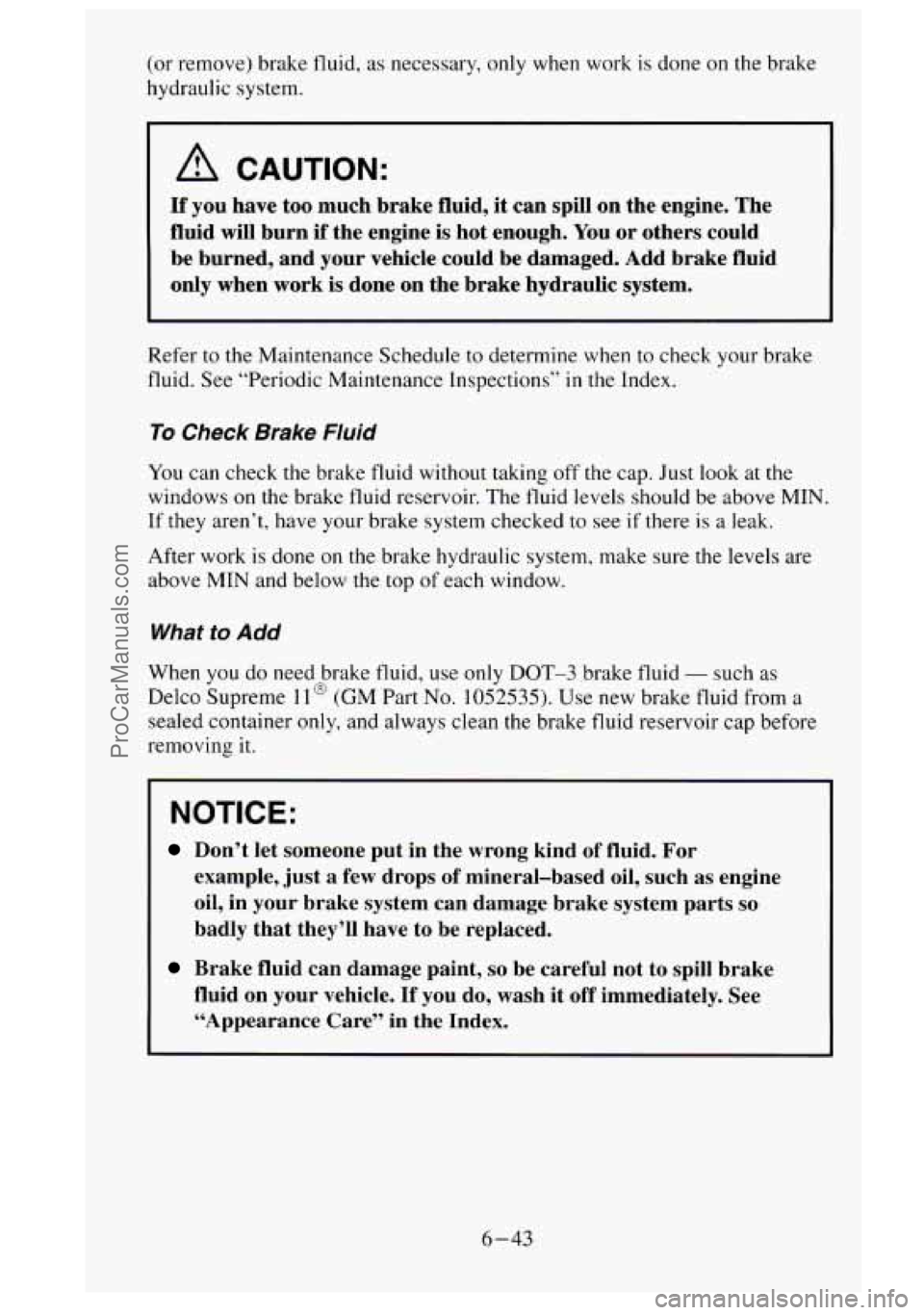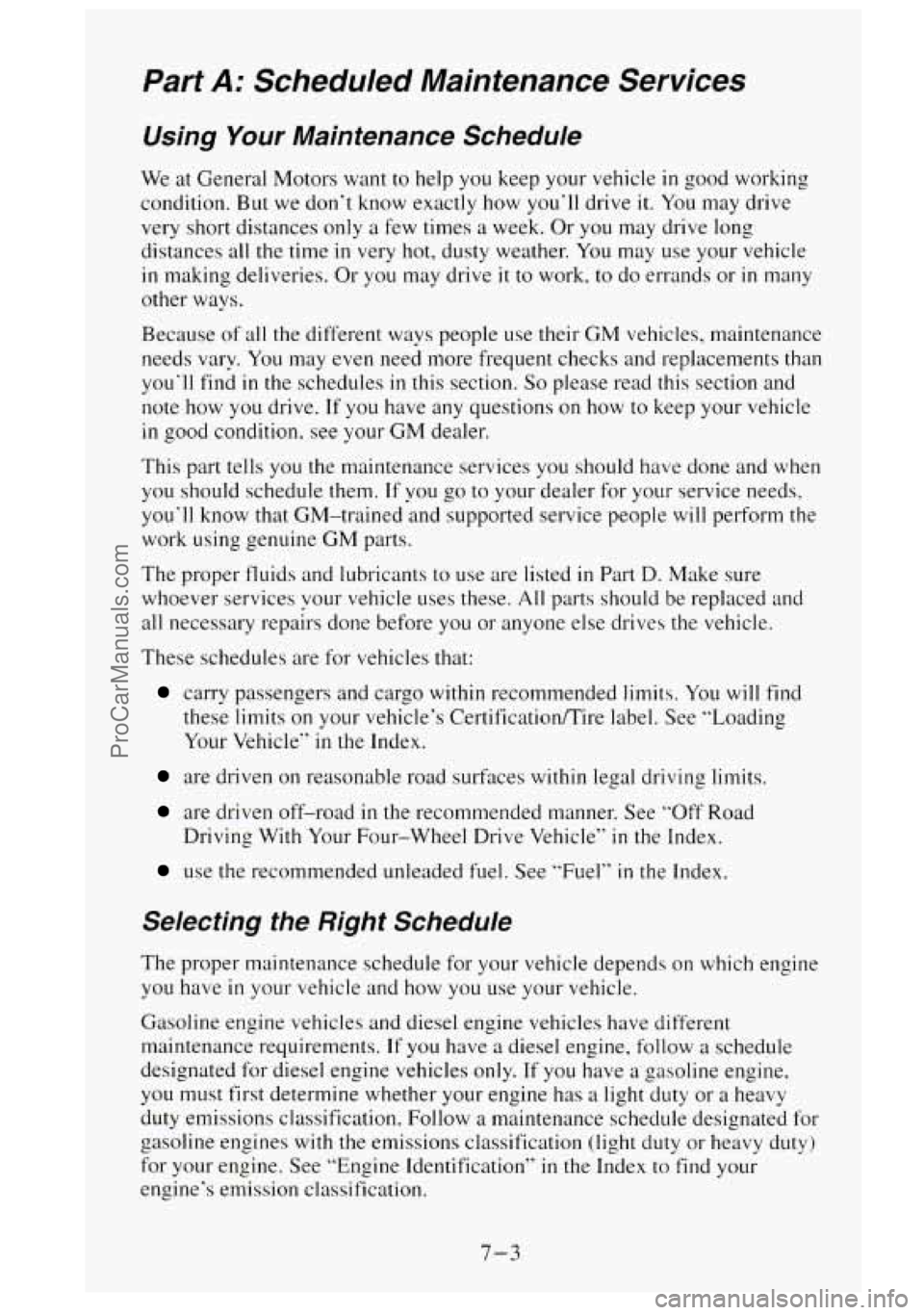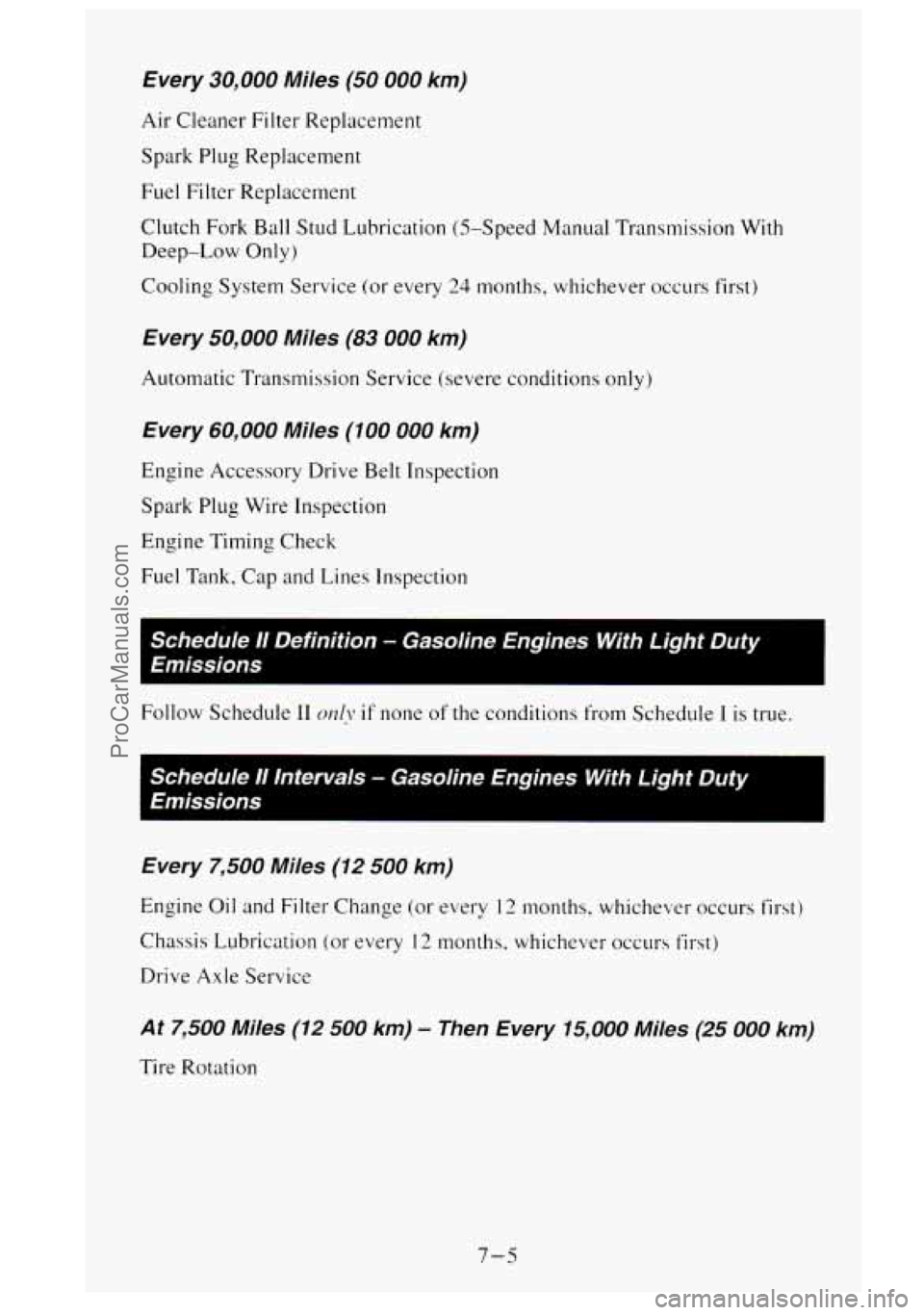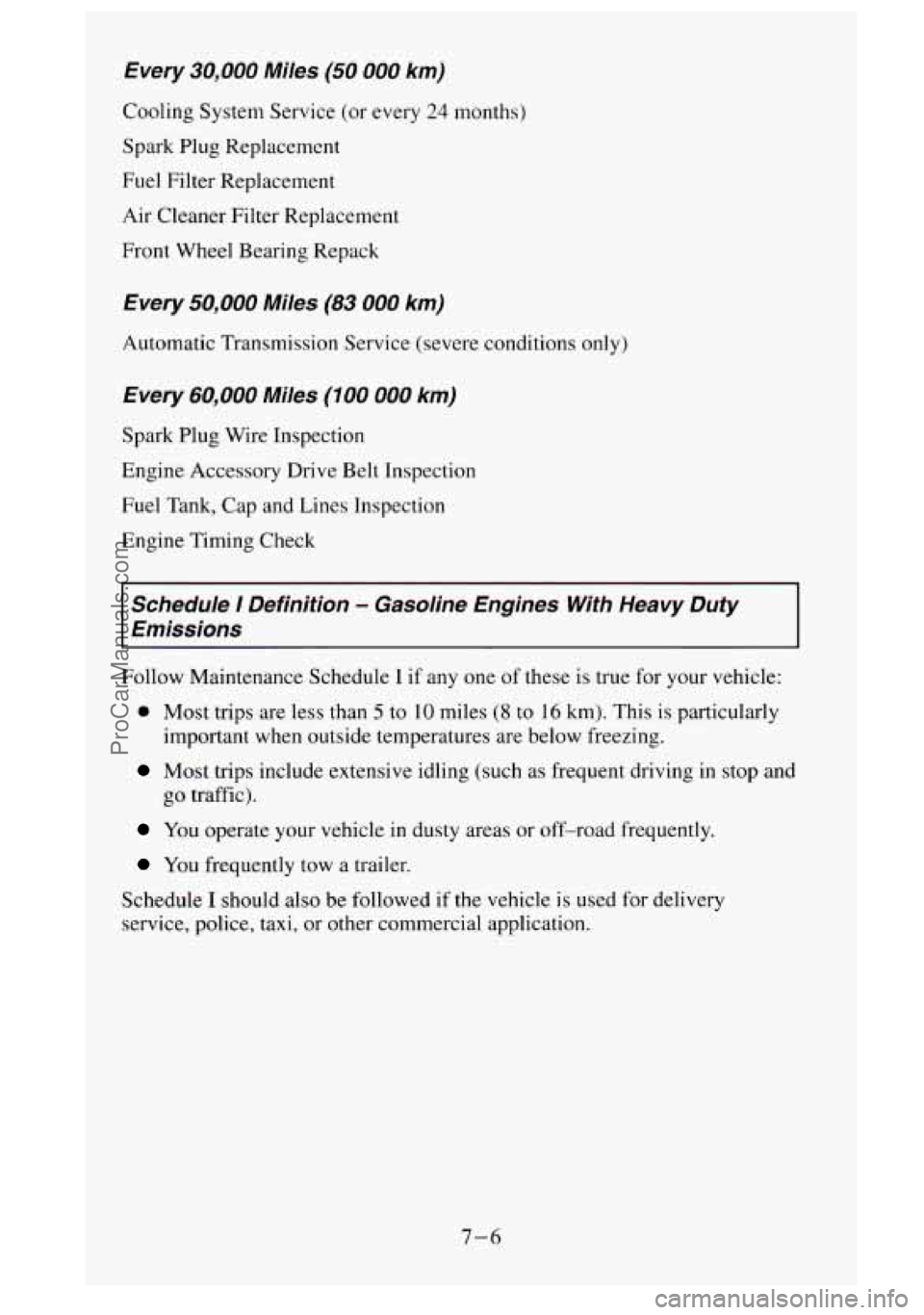Page 309 of 488

(or remove) brake fluid, as necessary, only when work is done on the brake
hydraulic system.
A CAUTION:
If you have too much brake fluid, it can spill on the engine. The
fluid will burn
if the engine is hot enough. You or others could
be burned, and your vehicle could be damaged. Add brake fluid
only when work is done on the brake hydraulic system.
Refer to the Maintenance Schedule to determine when to check your brake
fluid. See “Periodic Maintenance Inspections”
in the Index.
To Check Brake Fluid
You can check the brake fluid without taking off the cap. Just look at the
windows on the brake fluid reservoir. The fluid levels should be above MIN.
If they aren’t, have your brake system checked to see if there is a leak.
After work
is done on the brake hydraulic system, make sure the levels are
above MIN and below the top
of each window.
What to Add
When you do need brake fluid, use only DOT-3 brake fluid - such as
Delco Supreme 11
@ (GM Part No. 1052535). Use new brake fluid from a
sealed container only, and always clean the brake fluid reservoir cap before
removing it.
NOTICE:
Don’t let someone put in the wrong kind of fluid. For
example, just
a few drops of mineral-based oil, such as engine
oil, in your brake system can damage brake system parts
so
badly that they’ll have to be replaced.
Brake fluid can damage paint, so be careful not to spill brake
fluid on your vehicle.
If you do, wash it off immediately. See
“Appearance Care” in the Index.
6-43
ProCarManuals.com
Page 348 of 488
Wheel Nut Torque
MODEL
C 1500
K 1500 & C-K 2500
C-K 2500
(w/CGP)
C-K 3500
-Single Rear Wheels
C3500
-Dual Rear Wheels
C3500 HD
-Front
-Rear
DESCRIPTION
5 bolts ( 14mm)
6 bolts (14mm)
8 bolts ( 14mm)
8 bolts ( 14mm)
8 bolts (14rnm)
5 bolts (518 in.)
10 bolts (5/8 in.)
Cooling System Capacity
ENGINE
4.3L
5 .OL
5.7L
6.5L
6.5L
6.5L
7.4L
7.4L w/3500
HD
VIN
Z
H
K
P
S
F
N
N
TORQUE
120 ft. lbs. (1 60 Nmm)
120 ft. lbs. (160 Nmm)
120 ft. lbs. (160 Nom)
120
ft. lbs. (1 60 Nom)
140 ft. lbs. ( 190 Nmm)
175 ft. lbs. (240 Nom)
175 ft. lbs. (240 Nom)
QUANTITY*
13 Quarts (12.3 Liters)
17.5 Quarts (16.6
Liters)
17.5 Quarts (16.5
Liters)
23.5 Quarts (22.2
Liters)
23.5 Quarts (22.2
Liters)
23.5 Quarts (22.2
Liters)
25
Quarts (23.5 Liters)
28.5
Quarts (27 Liters)
After refill, the level
MUST be checked as outlined under “Engine Cooling
System”
in Section 5.
*All quantities are approximate.
6-82
ProCarManuals.com
Page 349 of 488
CranKcase Capacity
ENGINE
4.3L 5 .OL
5.7L“
6.5L
6.5L
6.5L
7.4L>$
VIN
Z
€4
K
P
S
F
N
QUANTITY WITH
FILTER*
4.5 Quarts (4.3 Liters)
5 Quarts (4.8 Liters)
5 Quarts (4.8 Liters)
7 Quarts (6.5 Liters)
7 Quarts
(6.5 Liters)
7 Quarts (6.5 Liters)
7 Quarts (6.5 Liters)
After refill, the level
MUST be checked as outlined under “Engine Oil And
Filter Recommendations”
in Section 5.
All quantities are approximate.
“Add one additional quart for
C3500 HD Models.
+Oil filter should be changed at EVERY oil change.
Fuel Tank Capacity
TYPE
Gasoline/Diesel
with Short Bed
with Long Bed
Crew Cab
Standard
Chassis-Cab Models
Standard (Side Tank)
Optional (Rear Tank)
3500 HD Models
Standard (Side Tank)
Optional (Rear Tank)
QUANTITY
26 Gallons (98 Liters)
34 Gallons
(1 28 Liters)
34 Gallons
(1 28 Liters)
23 Gallons (87 Liters)
3
1 Gallons (1 17 Liters)
23 Gallons (87 Liters)
3 1 Gallons ( 117 Liters)
All quantities are
for a completely dry tank and are approximate.
6-83
ProCarManuals.com
Page 356 of 488
LAMP OR BULB
INSTRUMENT
PANEL
Daytime Running
Lamps Indicator?
Charging System
Indicator Lamp
Instrument Cluster
Illumination
Headlamp Beam
Indicator
Directional Signal
Indicator
Brake Warning
Indicator
SIR (Air Bag)
Safety Belt Warning
Check Gages Indicator
Malfunction Indicator
(“Service Engine
Soon”) Lamp
Upshift Indicator Glow Plugs Lamp**
Low Coolant Lamp**
Water in Fuel Lamp**
Service Throttle Soon
Lamp**
**Diesel only
“fanadian Vehicles only
TRADE NO.
74
74
194
74
74
74
74
74
74
74
74
74
74
74
74
1
I
6
1
2
1
6-90
ProCarManuals.com
Page 359 of 488

Part A: Scheduled Maintenance Services
Using Your Maintenance Schedule
We at General Motors want to help you keep your vehicle in good working
condition. But we don’t know exactly how you’ll drive it. You may drive
very short distances only
a few times a week. Or you may drive long
distances all the time
in very hot, dusty weather. You may use your vehicle
in making deliveries. Or you may drive it to work, to do errands or in many
other ways.
Because
of all the different ways people use their GM vehicles, maintenance
needs varv.
You may even need more frequent checks and replacements than
you‘ll find
in the schedules in this section. So please read this section and
note how you drive. If you have any questions on how to keep your vehicle
in good condition. see your GM dealer.
This part tells you the maintenance services you should have done and
when
you should schedule them. If you go to your dealer for your service needs,
you’ll know that GM-trained and supported service people
will perform the
work using genuine
GM parts.
The proper fluids and lubricants to use are listed
in Part D. Make sure
whoever services your vehicle uses these.
All parts should be replaced and
all necessary repairs done before you or anyone else drives the vehicle.
These schedules are for vehicles that:
carry passengers and cargo within recommended limits. You will find
these limits on your vehicle’s CertificatiodTire label. See “Loading
Your Vehicle“
in the Index.
are driven on reasonable road surfxes within legal driving limits.
are driven off-road in the recommended manner. See “Off Road
Driving With Your Four-wheel Drive Vehicle”
in the Index.
use the recommended unleaded fuel. See “Fuel” in the index.
Selecting the Right Schedule
The proper maintenance schedule for your vehicle depends on which engine
you have
in your vehicle and how you use your vehicle.
Gasoline engine vehicles and diesel engine vehicles have different
maintenance requirements.
If you have a diesel engine, follow a schedule
designated for diesel engine vehicles only. If you have
a gasoline engine.
you must first determine whether your engine has
a light duty or a heavy
duty emissions classification. Follow a maintenance schedule designated
for
for your engine. See “Engine Identification” in the Index to find your
engine‘s emission classification.
c easoline engines with the emissions classification (light duty or heavy duty)
7-3
ProCarManuals.com
Page 361 of 488

Every 30,000 Miles (50 000 km)
Air Cleaner Filter Replacement
Spark Plug Replacement
Fuel Filter Replacement
Clutch
Fork Ball Stud Lubrication (5-Speed Manual Transmission With
Deep-Low Only)
Cooling System Service (or every
24 months, whichever occurs first)
Every 50,000 Miles (83 000 km)
Automatic Transmission Service (severe conditions only)
Every 60,000 Miles (100 000 km)
Engine Accessory Drive Belt Inspection
Spark Plug Wire Inspection
Engine Timing Check
Fuel Tank, Cap and Lines Inspection
Schedule 11 Definition - Gasoline Engines With Light Duty
Emissions
Follow Schedule I1 only if none of the conditions from Schedule I is true.
Schedule I1 Intervals - Gasoline Engines With Light Duty
Emissions
Every
7,500 Miles (12 500 km)
Engine Oil and Filter Change (or every 12 months, whichever occurs first)
Chassis Lubrication (or every
12 months, whichever occurs first)
Drive Axle Service
At 7,500 Miles (12 500 km) - Then Every 15,000 Miles (25 000 km)
Tire Rotation
7-5
ProCarManuals.com
Page 362 of 488

Every 30,000 Miles (50 000 km)
Cooling System Service (or every 24 months)
Spark Plug Replacement
Fuel Filter Replacement
Air Cleaner Filter Replacement
Front Wheel Bearing Repack
Every 50,000 Miles (83 000 km)
Automatic Transmission Service (severe conditions only)
Every 60,000 Miles (100 000 km)
Spark Plug Wire Inspection
Engine Accessory Drive Belt Inspection
Fuel Tank,
Cap and Lines Inspection
Engine Timing Check
Schedule 1 Definition - Gasoline Engines With Heavy Duiy
Emissions
I
Follow Maintenance Schedule I if any one of these is true for your vehicle:
0 Most trips are less than 5 to 10 miles (8 to 16 km). This is particularly
important when outside temperatures are below freezing.
Most trips include extensive idling (such as frequent driving in stop and
go traffic).
You operate your vehicle in dusty areas or off-road frequently.
You frequently tow a trailer.
Schedule
I should also be followed if the vehicle is used for delivery
service, police, taxi, or other commercial application.
7-6
ProCarManuals.com
Page 363 of 488

Schedule I Intervals - Gasoline Engines with Heavy Duty
Emissions
Every
3,000 Miles (5 000 km)
Engine Oil and Filter Change (or every 3 months, whichever occurs first)
Chassis Lubrication (or every
3 months, whichever occurs first)
Drive Axle Service
At 6,000 Miles (10 000 km) - Then Every 12,000 Miles (25 000 km)
Tire Rotation
Every 12,000 Miles (20 000 km)
Air Cleaner Filter Inspection, if Driving in Dusty Conditions
Front Wheel Bearing Repack (or at Each Brake Relining) (2-Wheel Drive
Only
1
Fuel Filter Replacement
Engine Accessory Drive Belt Inspection
Shields
and Underhood Insulation Inspection
Thermostatically Controlled Engine Cooling Fan Check (or every
12
months, whichever occurs first)
Every 24,000 Miles (40 000 km)
Cooling System Service (or every 24 months, whichever occurs first)
Air Cleaner Filter Replacement
Engine Timing Check
Thermostatically Controlled Air Cleaner Inspection
Air Intake System Inspection
Every 27,000 Miles (45 000 km)
Spark Plugs Replacement
Every 30,000 Miles (50 000 km)
Clutch Fork Ball Stud Lubrication (%Speed Transmission with Deep-Low
Only)
7-7
ProCarManuals.com